History of Bakhmut
Foundation of Bakhmut
The year of foundation of Bakhmut is considered to be 1571, when it was first mentioned in written sources as the border “Bakhmutovskaya outpost”. At this time, the Russian Tsar Ivan the Terrible, in order to repulse the Crimean Tatars and protect the southern border of the Russian state, ordered the creation of border guard posts along the Aidar and Siverskyi Donets rivers. In written sources for this year, Bakhmutovskaya outpost was mentioned as the 6th one out of seven.
However, this version of the origin of Bakhmut has been reasonably criticized, since all these mentioned border outposts were located on the left bank of the Siverskyi Donets River (Bakhmutovskaya - opposite the confluence of the Bakhmutovka River, hence the name; today, it is the village of Yampil located about 37 km north of Bakhmut). In any case, there was no permanent population in the outpost and it was not a settlement or a fortress, rather it was a meeting place for the Russian border guards to exchange information.
In the 17th century, the Cossack I. Biryukov discovered salt lakes near the Bakhmutovka River. At that time, salt extraction was a very profitable business. In some years, up to 10 thousand salt workers gathered in this area. In particular, such a salt-making center began to take shape in the area of today’s Bakhmut. As a full-fledged settlement in the place of salt extraction, Bakhmut was founded by the Cossacks of the Izium Sloboda Regiment around 1680-1690s.
More Historical Facts…
Bakhmut in the 18th centuries
In 1701, the Russian Tsar Peter I ordered the construction of a fortress called Bakhmut here. The protection of the Bakhmut salt extraction sites, as well as the extraction of salt for the needs of the Russian state, was entrusted to the Cossacks. In 1703, the fortress was built and subordinated to Fyodor Shidlovsky, Colonel of the Izium Sloboda Cossack Regiment.
In the autumn of 1705, a detachment of Don Cossacks, led by ataman Kondraty Bulavin, captured the Bakhmut saltworks. Later, this event developed into the Bulavin Rebellion (1707-1708). The conflict arose due to a series of contradictions between the Russian state, led by Peter I, the Cossacks and Russian peasants, who fled from serfdom to gain freedom in the more or less autonomous region of the Don.
After the defeat of the rebels, Shidlovsky took Bakhmut by storm and burned it. Peter I, who visited the ruins of Bakhmut in 1709, ordered the urgent restoration of the fortress and salt works.
In 1715, Bakhmut had a customs house, the town hall of the Izium Regiment, 15 barns and 9 forges. In 1732, the Intercession Church was built and consecrated. In 1748, the Bakhmut Cossack Cavalry Regiment was created. According to the List of Fortresses of 1764, the garrison of Bakhmut consisted of up to 2,500 infantry and 150 horsemen in wartime, and according to the Artillery List of Fortresses of 1765, the town had 60 cannons and 16 mortars.
In the middle of the 18th century, Bakhmut became the administrative center of Slavo-Serbia (1753-1764), an area of military agricultural settlements of Serbs, Moldavians, Bulgarians, and other Slavs on the southern bank of the Siverskyi Donets River. In 1764, the Bakhmut Hussar Regiment was created.
In 1765, Slavo-Serbia became part of the newly created New Russia (Novorossiya) Governorate. In the same year, one of the first strikes of workers at the enterprises of the Russian Empire took place here, the so-called Bakhmut strike, which was easily suppressed by military force.
In 1783, about 1,700 people lived in Bakhmut. There were 5 brick factories, a candle factory, a soap factory, a wax smelter, about 150 shops, a hospital, three schools and two private boarding schools for the children of wealthy parents, and a Sunday school for the children of workers. Bakhmut was a major trading center. Twice a year - on July 12 (the day of the Apostles Peter and Paul) and on September 21 (the day of the Nativity of the Blessed Virgin) - large fairs were held here.
Bakhmut in the 19th - early 20th centuries
In 1811, the coat of arms of Bakhmut was approved. In particular, it depicted the alchemical symbol of salt - a circle divided horizontally in half, meaning the principle of non-volatility and non-combustibility.
The abolition of serfdom in the Russian Empire in 1861 and the attraction of foreign capital gave rise to the rapid growth of local industrial production. In 1876, large reserves of rock salt were discovered in the Bakhmut basin.
In the 1870s, an enterprising Prussian engineer Edmund Farke built a glass, nail, alabaster, and brick factories in Bakhmut. Ivan Scaramanga, a merchant from Taganrog, opened a salt factory that produced about 32,000 tons of salt per year. In 1879, French-Belgian and Franco-German joint-stock companies began the construction of salt mines in Bakhmut. In 1885, the Bakhmut salt mines produced about 70% of Russian salt. As a result, the Russian Empire stopped importing salt from abroad.
In 1878, the Kharkiv-Mariupol and Kharkiv-Popasna railways were constructed, which was also of great importance for the development of Bakhmut. In 1897, 19,316 people lived in the city, including 11,928 Ukrainians, 3,659 Russians, and 3,223 Jews.
By 1900, there were 76 small industrial enterprises in Bakhmut, in which 1,078 workers were employed, as well as four salt mines (874 workers), which were part of the Bakhmut salt syndicate. At the beginning of the 20th century, metalworking began to develop here too. In 1913, the population of Bakhmut was about 28 thousand people.
In November 1917, after the Ukrainian Central Rada announced the creation of the Ukrainian People’s Republic, the blue and yellow Ukrainian flag was raised over the Bakhmut district council for the first time in Donbass. In December 1917, simultaneously with the Bolshevik rebellion in Luhansk, the Bolsheviks came to power in Bakhmut. In February 1918, they proclaimed the creation of the Donetsk-Krivoy Rog Soviet Republic.
In April 1918, with the support of the Austro-German troops, units of the Donetsk group of the army of the Ukrainian People’s Republic regained control of Bakhmut. In November 1918, after the revolution in Germany, the German troops retreated from the city. On December 25, 1919, the Red Army returned to Bakhmut and the Soviet period began in the history of the city.
Bakhmut in the 1920s-2020s
In 1920-1925, Bakhmut was the administrative center of the Donetsk Governorate. On September 12, 1924, the city was renamed Artyomovsk (Artemovsk) after the pseudonym “Artyom” of the Bolshevik party and statesman Fyodor Sergeyev (1883-1921), one of the founders of the Donetsk-Krivoy Rog Soviet Republic.
In 1939, the population of the city was 55,409 people. On November 1, 1941, during World War II, it was occupied by German troops. On September 5, 1943, the Red Army returned to Artemovsk.
In the early 1950s, construction of a non-ferrous metal processing plant began on the northern outskirts of the city. In 1951, the Artemovsk factory of sparkling wines, the largest in Europe, was opened in the city. Today, PRJSC “ARTWINERY” is one of the largest enterprises in Eastern Europe producing sparkling wines using the classic bottle method. In 1959, the city’s population was 60,626 people.
In 1964, the All-Union Scientific Research Institute of the Salt Industry was opened in Artemovsk. In the 1960s, a new movie theater “Cosmos” and a central clinic were built. In 1968, the first trolleybuses appeared in the city. In 1989, about 90 thousand people lived in Artemovsk.
In 1991, shortly before the declaration of independence of Ukraine, a local referendum was initiated on the return of the historical name to the city - Bakhmut. However, the initiative was not supported - only 25% of the residents voted for it.
On April 12, 2014, as in many other cities of Donbass, the separatists proclaimed the Donetsk People’s Republic in Artemivsk. On May 25, 2014, they managed to disrupt the holding of presidential elections in Ukraine in the city. On July 6, 2014, it was liberated by units of the National Guard and the Armed Forces of Ukraine.
On September 23, 2015, the Artemivsk city council decided to return the historical name of the city - Bakhmut. The Verkhovna Rada of Ukraine approved the decision on renaming on February 4, 2016.
In May 2022, during the Russian invasion of Ukraine, the front line came close to Bakhmut, it began to be subjected to regular shelling and became an important center of the Ukrainian defensive line in Donetsk Oblast. By the fall of 2022, the city’s population dropped to about 15,000 people, most of its residents left on their own or were evacuated.
Streets of Bakhmut
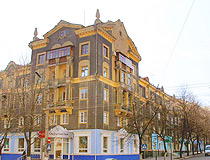
Bakhmut architecture
Author: Sotnikov
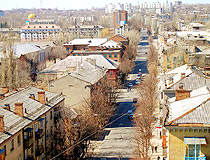
Bakhmut cityscape
Author: Sotnikov
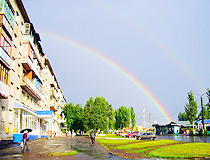
Summer in Bakhmut
Author: Sotnikov
Bakhmut - Features
Bakhmut is located in the northeastern part of Donetsk Oblast, about 580 km from Kyiv in a straight line. The Siverskyi Donets - Donbass canal runs seven kilometers from the city. Built in 1953-1958, it is of great importance for the city’s water supply. According to the 2001 census, the population of Bakhmut was 83,146 people, of which 27.61% said that their mother tongue was Ukrainian, 71.07% - Russian.
The city got its name from the Bakhmut (Bakhmutovka) River on the banks of which it was founded. The name of the river probably comes from the Turkic word “bakhmat” meaning “steppe horse”. Initially, this word acted as a definition in relation to the Turkic word “su” meaning “water, river”. That is, from “Bakhmat su” over time it turned into “Bakhmut”. This hypothesis is supported by the presence in the same area of the Zherebets (“Stallion”) River. In this case, the Bakhmut River can be interpreted as a river, on the banks of which herds of steppe horses (bakhmats) grazed in the old days.
However, another explanation is no less likely, that the name of the river is based on the Turkic name Mahmut - a variant of the name Muhammad. If this is so, then the hydronym Bakhmut arose from the phrase Makhmut su, that is, the Makhmut’s River. This version is supported by the presence of the Aidar River in this region, correlated with the Turkic name Aidar. The connection of the name of the river with some specific person (possibly a Turkic nomad) is indirectly indicated by the variant of the hydronym in the form of a possessive adjective - Bakhmutov, on the basis of which the variant of the name Bakhmutovka later appeared.
The coat of arms of Bakhmut symbolizes the natural wealth of the Bakhmut land and the main occupation of the local population - salt extraction. It was approved by the Russian Emperor Alexander I in 1811. The green color of the upper field of the coat of arms is a symbol of the fertility of the Bakhmut land, the black color of the lower field is a symbol of the richness of the subsoil. In the middle, between the green and black fields, is the alchemical sign of salt.
The climate in Bakhmut is temperate continental. Summer is hot and dry. The average monthly temperature in July is plus 22 degrees Celsius. In winter, the weather is changeable, sometimes very cold. The average temperature in January is minus 6 degrees Celsius.
Historically, Bakhmut is a major center for the extraction of rock salt (more than 30% of production in Ukraine). Salt mines are located in the nearby town of Soledar (this name literally means “giving salt”). The maximum annual production of the enterprise “Artemsil” exceeded 7 million tons in 1991. Also in Bakhmut there is a plant for the processing of non-ferrous metals (the only one in Ukraine) and several other industrial enterprises. “Artwinery” company is one of the largest enterprises in Eastern Europe producing sparkling wines using the classic bottle method.
Main Attractions of Bakhmut
Salt Mines of Soledar. “Artemsil” is one of the largest rock salt producers in Europe and the oldest salt extraction enterprise in Ukraine. It is located in the small town of Soledar, about 10 km northeast of Bakhmut. Over the centuries of salt mining, another “town” was formed in Soledar - an underground one. The total length of its “streets” is over 300 kilometers, along which about 3,000 chambers of various, including very large, sizes have been cut down.
During a tour of this salt labyrinth, you will see a lot of sculptures carved by masters in salt rock, a concert hall where the International Symphony Music Festival is held, a football field, the size of a nine-story building, a church, a salt copy of Mertsalov’s palm tree (one of the symbols of Donetsk Oblast), and other unique objects. The unique atmosphere of this salt world is enhanced by multi-colored illumination.
It should also be noted that staying in salt mines has a healing effect. There is a salt sanatorium here helping to improve the health of patients suffering from diseases of the bronchopulmonary system (except for oncology and tuberculosis) and diseases of the thyroid gland.
Artemivsk Plant of Sparkling Wines (PRJSC “ARTWINERY”). Its history began in the middle of the 18th century, when the development of gypsum deposits began in Bakhmut. In 1950, on the basis of gypsum galleries, a wine storage was created and the construction of a sparkling wine plant with a capacity of 5 million bottles per year began. In 2005, its productivity reached 300 million bottles.
At international and all-Ukrainian competitions, the company’s wines received a lot of awards. The wine is aged in underground alabaster adits at a depth of 72 meters, where about 30 million bottles of wine are stored at the same time.
The tour includes a visit to production workshops of the plant, where you can see all the stages of sparkling wine production. Tourists are also offered tasting, which is held in various themed halls. Patrisa Lumumby Street, 87.
Church of St. Nicholas the Wonderworker - one of the oldest churches in the Donbass. This wooden church was built in the style of Sloboda Ukraine architectural traditions in 1797. In 1858, the Russian Emperor Alexander II approved the construction of a bell tower. The three-tiered stone bell tower in honor of John the Baptist was built in 1861. Shevchenka Street, 8.
Bakhmut Museum of Local Lore. The museum occupies a building that is a monument of history and culture, built by the local industrialist V.G. Frantsuzov in 1911. Its collection includes about 30 thousand exhibits from ancient and medieval history, ethnography, Ukrainian culture, life and crafts of the local population, photos and archival documents, as well as paintings created by local artists. The exposition of the museum is exhibited in 14 halls. Nezalezhnosti Street, 26.



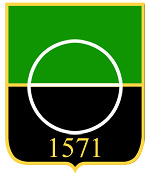



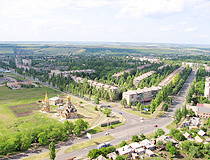
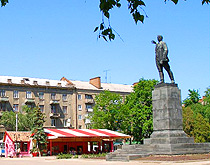
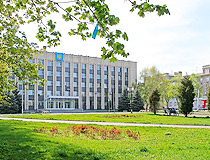
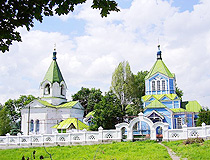
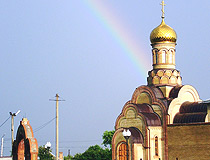
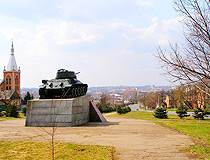
The comments of our visitors